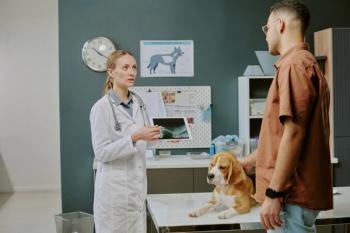
Gut check
This content is sponsored by Nutramax Laboratories.
Probiotics are defined as live microorganisms that confer health benefits on the host when administered in adequate amounts.1 Although most probiotics are bacteria, yeast species may also meet these criteria. Increasingly, probiotic quantity, intestinal epithelium adhesion capability, antimicrobial activity, and antioxidant potential have been recognized as important for probiotic efficacy.2 Prebiotics, nondigestible substrates that selectively promote growth of beneficial microbes, often are combined with probiotics in synbiotic formulations. Prebiotics selected for use in synbiotics might enhance activity of included probiotics, those of native microorganisms, or both. Pro- and synbiotics exert their effects by shifting the host’s microbiome and its metabolome to influence local gut function and systemic physiology.3 They support intestinal colonization, crowd out pathogenic bacteria, and enhance host immune function and digestive health.2 Their use in veterinary medicine has expanded rapidly in recent years. Both are used increasingly to manage gastrointestinal (GI) and extra-GI issues.4-8 This could be due to increasing client demand for natural or alternative modalities, intolerance of conventional management’s side effects, and/or failure of said management options to optimize patient outcomes. There is an expanding body of evidence supporting their use in the management of acute diarrhea, chronic enteropathy, and antibiotic-associated GI signs.
Common gastrointestinal applications
Stress and self-limiting gastroenteritis
Research does not show universal support for probiotics in managing stress-related GI signs. In adequately powered studies, pro/synbiotics decreased feline and canine diarrhea in shelter environments.9,10 In contrast, probiotics have not been shown to reduce diarrhea in weanling kittens,11 working dogs under quarantine,12 or racing Alaskan sled dogs, except during a weeklong contagious outbreak.13
The impact on self-limiting gastroenteritis has been more consistently positive. Probiotics have been shown to decrease the duration of self-limiting diarrhea, whether accompanied by vomiting or not, in dogs by 32% to 41% compared with controls in multiple randomized trials.14-17 Probiotics also have been found to significantly decrease hyporexia and vomiting,18 the use of rescue antibiotics,15 and withdrawal from research studies for "rescue" therapy such as antiemetics and antibiotics.16 Finally, resolution of acute diarrhea significantly correlated with probiotic administration and dietary modification but not antibiotics in a large observational study.8 Synbiotic administration also can help maintain microbiome stability and normalize the dysbiosis index (DI), whereas metronidazole causes severe disruptions in the microbiome and metabolome.19,20
Infectious gastroenteritis
Probiotics reduce the severity of clinical signs of some types of infectious gastroenteritis, although adequately powered study results are limited. In one study, dogs with naturally occurring parvovirus enteritis were administered conventional therapy alone or in combination with a high-dose, multistrain probiotic cocktail. Clinical illness scores, determined using objective criteria, were significantly lower on days 3 and 5 for dogs administered the probiotic than for dogs receiving standard supportive care alone.21 Mortality was also lower, though this difference was not statistically significant. Positive results were also identified for dogs with distemper virus-related diarrhea in a lower-quality trial.22
Although clinical illness scores differed significantly from baseline 1 day earlier in dogs with acute hemorrhagic diarrhea syndrome (AHDS) given probiotics vs placebo, scores were not statistically compared between groups; scores were clinically equivalent between groups at each time point, and all dogs responded well to management.23 There also were no significant differences in clinical recovery time, appetite, or stool consistency in dogs with AHDS administered probiotics vs fecal microbiota transplantation in a subsequent study,24 with rapid clinical improvement noted in both groups. Because there was no placebo group in the second study, it is unclear whether these findings indicate that the treatments had equivalent efficacy or no impact on outcomes. Further study with adequate controls is warranted to determine the value of probiotics for management of AHDS.
Non–food-responsive chronic enteropathy
Cats with idiopathic chronic enteropathy (CE) administered a multistrain synbiotic (Proviable®-DC) had significantly improved fecal scores in an open-label trial.25 Similarly, 9 of 10 cats with idiopathic constipation/megacolon administered a high-dose probiotic in an uncontrolled trial had clinical resolution of signs, with clinically and statistically significant histologic improvement.26
Clinical activity scores similarly improved in dogs with large-bowel dysmotility administered probiotics and a hydrolyzed, high-fiber diet.27,28 Clinical activity scores, defecation frequency, and fecal consistency also were significantly improved in dogs with CE administered Saccharomyces boulardii vs placebo in addition to conventional management,29 as well as in dogs with CE or colonic polyps given a high-dose multistrain bacterial probiotic.30 In another randomized controlled trial, clinical and histologic response rates did not differ for dogs treated with prednisone/metronidazole vs the same probiotic cocktail, with enhanced T regulatory cell function and dysbiosis normalization only in the probiotic group.31 A follow-up randomized controlled study found no difference between dogs administered diet and prednisone alone compared with the probiotic,32 suggesting probiotic effects may be blunted by prednisone coadministration. Finally, dogs with CE administered a synbiotic combined with immunoglobulin Y (IgY) in a randomized, double-blind, placebo-controlled study had significantly improved clinical activity scores, inflammatory markers, and beneficial shifts in mucosal microbiota.33
Chemotherapy-induced adverse gastrointestinal signs
One small, randomized controlled trial evaluated the impact of probiotics on chemotherapy-induced GI signs in dogs receiving CHOP chemotherapy for multicentric lymphoma.34 Dogs administered probiotics had no episodes of diarrhea, whereas 4 of 5 dogs in the control group developed diarrhea. Similarly, vomiting was noted in 1 in 5 dogs administered probiotics vs 4 in 5 dogs in the placebo group. However, differences between groups were not statistically significant. No dog administered probiotics developed secondary sepsis, even though 4 of 5 dogs developed chemotherapy-induced neutropenia (grade 1, 2 dogs; grade 3 and 4, 1 dog each).
Antibiotic-associated gastrointestinal signs (AAGS)
Probiotic administration significantly decreased the duration of lincomycin-induced diarrhea in healthy dogs, and diarrhea did not develop when administered concurrently with antibiotics.35 Oral probiotic administration also prevented antibiotic-induced dysbiosis in dogs administered cefovecin following surgery, whereas bacterial diversity significantly decreased in dogs administered cefovecin alone.36 These results suggest positive effects of probiotics in animals receiving injectable antibiotics, although further study is warranted prior to making widespread recommendations.
Results for preventing of AAGS due to oral antibiotics are more mixed. Administration of a probiotic 2 hours prior to administration of amoxicillin/clavulanate did not significantly decrease AAGS in cats in one study.37 In another study, coadministration of a synbiotic with clindamycin also did not decrease diarrhea in cats38; however, vomiting occurred less frequently in the synbiotic group.32 In a follow-up crossover study, administration of a higher-dose synbiotic (Proviable®-Forte) 1 hour after clindamycin was associated with significantly increased food intake and decreased vomiting in cats, and cats receiving the synbiotic were more likely to complete the initial phase of the study.1 Significant differences also were identified for food intake between the initial treatment period and after a 6-week washout, a phenomenon known as period effects. Period effects indicate the washout time between treatments was inadequate to prevent carryover effects from the initial treatment received. In this case, food intake required to maintain weight was significantly higher at the start of period 2 for cats initially in the placebo group, consistent with the development of antibiotic-induced CE. Several other cats from the placebo group had persistent diarrhea at the end of the washout period, although period effects were not statistically confirmed. Differences in successful completion of the treatment period between the first and second phases of the study suggest that the beneficial effects of synbiotics persisted for at least 6 weeks after administration.
Similarly, in a crossover study with an 8-week washout, derangements in food intake were significantly lower for dogs administered a bacterial/yeast synbiotic combination (Proviable®-Forte with Mycequin®) 1 hour after receiving enrofloxacin/metronidazole compared with placebo.39 Although vomiting and diarrhea did not statistically differ between groups, both were less severe during the second phase of the study. Because AAGS worsen with repeated exposure, the presence of less severe signs during or after synbiotic administration suggests a protective effect of the synbiotic combination against future AAGS. Significant differences in the microbiome and metabolome between groups also were found in several studies.3,38,40 Based on these results, administration of a synbiotic 1 to 2 hours after oral antibiotic administration has the highest likelihood of minimizing AAGS in cats and dogs.
Choosing a probiotic: Selection considerations
Neither prebiotics nor probiotics are regulated as drugs in the United States. In one study, less than one-third of evaluated probiotics labeled for animal use met or exceeded the type and quantity of viable organisms listed on their labels.41 For this reason, only probiotics that undergo regular evaluations for content and viability by their manufacturers should be used.
The most important criterion in product selection is demonstrated efficacy in relevant peer-reviewed literature. Standardized evaluation criteria relating to microbiota composition, SCFA production capability, and clinical indices also are being developed to improve assessment consistency across studies in dogs and cats.2
Product species, microbial strains, and total microorganisms (colony-forming units) should be considered when scientific data are lacking. Commercial probiotics contain between 1 and 20 or more microorganism species or strains. More potent products (those containing more colony-forming units and microbial strains) are recommended for the management of metabolic and GI disorders based on correlations between dose and efficacy in humans.42-44 Yeast probiotics might be preferable for immunocompetent patients receiving antibiotics, because they will not be inactivated if administered concurrently. Products containing prebiotics and probiotics (i.e., synbiotics) often are preferred for GI disorders because they act synergistically to support colonocyte health, prevent binding of pathogenic bacteria, and enhance probiotic growth.2 Other considerations when selecting a product include administration details (such as ability to mix in food), storage requirements, and the inclusion of animal proteins as flavorants, which could adversely impact patients with food sensitivity.
The future of probiotics
Probiotics rarely have adverse effects when appropriately administered, but an evidence-based approach to product selection and dosing is essential for maximal efficacy. Only products that undergo regular testing for content and viability should be used. Limited but moderate- to high-quality evidence supports probiotic or synbiotic administration for management of shelter-induced diarrhea, self-limiting gastroenteritis, parvovirus, intestinal dysmotility, chemotherapy-associated GI signs, and CE in cats and dogs. Randomized, blinded placebo-controlled studies support the use of Proviable®-Forte administered alone or in combination with Mycequin® to mitigate AAGS in patients receiving antibiotics. Evidence also supports the use of probiotics for some extra-gastrointestinal disorders such as chronic kidney disease.5 Benefits of probiotics in the management of canine anxiety have been reported in abstract form,45 but the abstract lacked the detail required to determine the clinical effect. Until study results are published in a peer-reviewed format, an evidence-based recommendation cannot be made regarding the use of probiotics for anxiety. Results for other disorders such as canine atopy are mixed,4,6,7,46 with positive results found primarily in studies using probiotics with higher colony-forming units.4,6,7 This emphasizes the importance of careful product selection, dosing, and attention to details of published research.
References
- Stokes JE, Price JM, Whittemore JC. Randomized, Controlled, Crossover trial of Prevention of Clindamycin-Induced Gastrointestinal Signs Using a Synbiotic in Healthy Research Cats. J Vet Intern Med. 2017;31(5):1406-1413. doi:10.1111/jvim.14795
- Xia J, Cui Y, Guo Y, Liu Y, Deng B, Han S. The Function of Probiotics and Prebiotics on Canine Intestinal Health and Their Evaluation Criteria. Microorganisms. 2024;12(6):1248. Published 2024 Jun 20. doi:10.3390/microorganisms12061248
- Whittemore JC, Stokes JE, Price JM, Suchodolski JS. Effects of a synbiotic on the fecal microbiome and metabolomic profiles of healthy research cats administered clindamycin: a randomized, controlled trial. Gut Microbes. 2019;10(4):521-539. doi:10.1080/194 90976.2018.1560754
- Kim H, Rather IA, Kim H, et al. A Double-Blind, Placebo Controlled-Trial of a Probiotic Strain Lactobacillus sakei Probio-65 for the Prevention of Canine Atopic Dermatitis. J Microbiol Biotechnol. 2015;25(11):1966-1969. doi:10.4014/jmb.1506.06065
- Lippi I, Perondi F, Ceccherini G, Marchetti V, Guidi G. Effects of probiotic VSL#3 on glomerular filtration rate in dogs affected by chronic kidney disease: A pilot study. Can Vet J. 2017;58(12):1301-1305.
- Marsella R. Evaluation of Lactobacillus rhamnosus strain GG for the prevention of atopic dermatitis in dogs. Am J Vet Res. 2009;70(6):735-740. doi:10.2460/ajvr.70.6.735
- Marsella R, Santoro D, Ahrens K. Early exposure to probiotics in a canine model of atopic dermatitis has long-term clinical and immunological effects. Vet Immunol Immunopathol. 2012;146(2):185-189. doi:10.1016/j.vetimm.2012.02.013
- Singleton DA, Noble PJM, Sánchez-Vizcaíno F, et al. Pharmaceutical Prescription in Canine Acute Diarrhoea: A Longitudinal Electronic Health Record Analysis of First Opinion Veterinary Practices. Front Vet Sci. 2019;6:218. Published 2019 Jul 2. doi:10.3389/fvets.2019.00218
- Bybee SN, Scorza AV, Lappin MR. Effect of the probiotic Enterococcus faecium SF68 on presence of diarrhea in cats and dogs housed in an animal shelter. J Vet Intern Med. 2011;25(4):856-860. doi:10.1111/j.1939-1676.2011.0738.x
- Rose L, Rose J, Gosling S, Holmes M. Efficacy of a Probiotic-Prebiotic Supplement on Incidence of Diarrhea in a Dog Shelter: A Randomized, DoubleBlind, Placebo-Controlled Trial. J Vet Intern Med. 2017;31(2):377-382. doi:10.1111/jvim.14666
- Marks S, McDonnel S, Smith C, et al. Effect of the probiotic Enterococcus faecium SF 68 on presence of diarrhea in weanling kittens (abstr.). J Vet Intern Med 2015;29:1186.
- Cooper S, Parnell N, Isaiah A, et al. Effect of Bifidobacterium animalis AHC7 and tylosin on the microbiome during the quarantine period of military working dogs (abstr.). J Vet Intern Med 2015;29:1188 (GI-1129).
- Gagné JW, Wakshlag JJ, Simpson KW, et al. Effects of a synbiotic on fecal quality, short-chain fatty acid concentrations, and the microbiome of healthy sled dogs. BMC Vet Res. 2013;9:246. Published 2013 Dec 5. doi:10.1186/1746-6148-9-246
- Herstad HK, Nesheim BB, L’Abée-Lund T, Larsen S, Skancke E. Effects of a probiotic intervention in acute canine gastroenteritis–a controlled clinical trial. J Small Anim Pract. 2010;51(1):34-38. doi:10.1111/j.1748-5827.2009.00853.x
- Kelley RL, Minikhiem D, Kiely B, et al. Clinical benefits of probiotic canine-derived Bifidobacterium animalis strain AHC7 in dogs with acute idiopathic diarrhea. Vet Ther. 2009;10:121-130.
- Nixon SL, Rose L, Muller AT. Efficacy of an orally administered anti-diarrheal probiotic paste (Pro-Kolin Advanced) in dogs with acute diarrhea: A randomized, placebo-controlled, double-blinded clinical study. J Vet Intern Med. 2019;33:1286-1294
- Shmalberg J, Montalbano C, Morelli G, Buckley GJ. A Randomized Double Blinded Placebo-Controlled Clinical Trial of a Probiotic or Metronidazole for Acute Canine Diarrhea. Front Vet Sci. 2019;6:163. Published 2019 Jun 4. doi:10.3389/fvets.2019.00163
- Gómez-Gallego C, Junnila J, Männikkö S, et al. A canine-specific probiotic product in treating acute or intermittent diarrhea in dogs: A double-blind placebocontrolled efficacy study. Vet Microbiol. 2016;197:122- 128. doi:10.1016/j.vetmic.2016.11.015
- Stübing H, Suchodolski JS, Reisinger A, et al. The Effect of Metronidazole versus a Synbiotic on Clinical Course and Core Intestinal Microbiota in Dogs with Acute Diarrhea. Vet Sci. 2024;11(5):197. Published 2024 Apr 29. doi:10.3390/vetsci11050197
- Chaitman J, Ziese A-L, Pilla R, et al. Fecal microbial and metabolic profiles in dogs with acute diarrhea receiving either fecal microbiota transplantation or oral metronidazole. Frontiers in Veterinary Science. 2020;7:192.
- Arslan HH, Aksu DS, Terzi G, et al. Therapeutic effects of probiotic bacteria in parvoviral enteritis in dogs. Revue Méd Vét. 2012;163:55-59.
- Delucchi L, Fraga M, Zunino P. Effect of the probiotic Lactobacillus murinus LbP2 on clinical parameters of dogs with distemper-associated diarrhea. Can J Vet Res. 2017;81(2):118-121.
- Ziese A-L, Suchodolski JS, Hartmann K, et al. Effect of probiotic treatment on the clinical course, intestinal microbiome, and toxigenic Clostridium perfringens in dogs with acute hemorrhagic diarrhea. PLoS One. 2018;13:e0204691
- Jugan MC, KuKanich K, Freilich L. Clinical response in dogs with acute hemorrhagic diarrhea syndrome following randomized probiotic treatment or fecal microbiota transplant. Front Vet Sci. 2023;10:1050538. Published 2023 Feb 2. doi:10.3389/fvets.2023.1050538
- Hart ML, Suchodolski JS, Steiner JM, Webb CB. Open-label trial of a multi-strain synbiotic in cats with chronic diarrhea. J Feline Med Surg. 2012;14(4):240- 245. doi:10.1177/1098612X11434386
- Rossi G, Jergens A, Cerquetella M, et al. Effects of a probiotic (SLAB51™) on clinical and histologic variables and microbiota of cats with chronic constipation/ megacolon: a pilot study. Benef Microbes. 2018;9(1):101- 110. doi:10.3920/BM2017.0023
- Rossi G, Cerquetella M, Gavazza A, et al. Rapid Resolution of Large Bowel Diarrhea after the Administration of a Combination of a High-Fiber Diet and a Probiotic Mixture in 30 Dogs. Vet Sci. 2020;7(1):21. Published 2020 Feb 10. doi:10.3390/vetsci7010021
- Rossi G, Gioacchini G, Pengo G, et al. Enterocolic increase of cannabinoid receptor type 1 and type 2 and clinical improvement after probiotic administration in dogs with chronic signs of colonic dysmotility without mucosal inflammatory changes. Neurogastroenterol Motil. 2020;32(1):e13717. doi:10.1111/nmo.13717
- D’Angelo S, Fracassi F, Bresciani F, et al. Effect of Saccharomyces boulardii in dogs with chronic enteropathies: double-blinded, placebo-controlled study. Vet Rec. 2018;182:258.
- Rossi G, Cerquetella M, Scarpona S, et al. Effects of probiotic bacteria on mucosal polyamines levels in dogs with IBD and colonic polyps: a preliminary study. Benef Microbes. 2018;9(2):247-255. doi:10.3920/BM2017.0024
- Rossi G, Pengo G, Caldin M, et al. Comparison of microbiological, histological, and immunomodulatory parameters in response to treatment with either combination therapy with prednisone and metronidazole or probiotic VSL#3 strains in dogs with idiopathic inflammatory bowel disease. PLoS One. 2014;9(4):e94699. Published 2014 Apr 10. doi:10.1371/ journal.pone.0094699
- White R, Atherly T, Guard B, et al. Randomized, controlled trial evaluating the effect of multi-strain probiotic on the mucosal microbiota in canine idiopathic inflammatory bowel disease. Gut Microbes. 2017;8:451-466.
- Sahoo DK, Allenspach K, Mochel JP, et al. Synbiotic-IgY Therapy Modulates the Mucosal Microbiome and Inflammatory Indices in Dogs with Chronic Inflammatory Enteropathy: A Randomized, Double-Blind, Placebo-Controlled Study. Vet Sci. 2022;10(1):25. Published 2022 Dec 30. doi:10.3390/ vetsci10010025
- Jugan MC, Wouda RM, Higginbotham ML. Preliminary evaluation of probiotic effects on gastrointestinal signs in dogs with multicentric lymphoma undergoing multi-agent chemotherapy: A randomised, placebo-controlled study. Vet Rec Open. 2021;8(1):e2. Published 2021 Mar 29. doi:10.1002/vro2.2
- Aktas MS, Borku MK, Ozkanlar Y. Efficacy of Saccharomyces boulardii as a probiotic in dogs. Bull Vet Inst Pulawy. 2007;51:365-369.
- Han DW, Kang JH, Mun SH, Kim SJ, Kim YH, Hwang CY. Preliminary report: Protective effects of probiotics on cefovecin-induced gut dysbiosis in dogs. Can J Vet Res. 2025;89(1):32-35.
- Torres-Henderson C, Summers S, Suchodolski J, et al. Effect of Enterococcus faecium strain SF68 on gastrointestinal signs and fecal microbiome in cats administered amoxicillin-clavulanate. Top Companion Anim Med. 2017;32:104-108.
- Whittemore JC, Stokes JE, Laia NL, et al. Short and long-term effects of a synbiotic on clinical signs, the fecal microbiome, and metabolomic profiles in healthy research cats receiving clindamycin: a randomized, controlled trial. PeerJ. 2018;6:e5130.
- Whittemore JC, Moyers TD, Price JM. Randomized, controlled, crossover trial of prevention of antibioticinduced gastrointestinal signs using a synbiotic mixture in healthy research dogs. J Vet Intern Med. 2019;33(4):1619-1626. doi:10.1111/jvim.15553
- Whittemore JC, Price JM, Moyers T, Suchodolski JS. Effects of Synbiotics on the Fecal Microbiome and Metabolomic Profiles of Healthy Research Dogs Administered Antibiotics: A Randomized, Controlled Trial. Front Vet Sci. 2021;8:665713. Published 2021 May 26. doi:10.3389/fvets.2021.665713
- Weese JS, Martin H. Assessment of commercial probiotic bacterial contents and label accuracy. Can Vet J. 2011;52(1):43-46.
- Ouwehand AC, Forssten S, Hibberd AA, Lyra A, Stahl B. Probiotic approach to prevent antibiotic resistance. Ann Med. 2016;48(4):246-255. doi:10.3109/07853890. 2016.1161232
- Pagnini C, Saeed R, Bamias G, Arseneau KO, Pizarro TT, Cominelli F. Probiotics promote gut health through stimulation of epithelial innate immunity. Proc Natl Acad Sci U S A. 2010;107(1):454-459. doi:10.1073/ pnas.0910307107
- Szajewska H, Konarska Z, Kołodziej M. Probiotic Bacterial and Fungal Strains: Claims with Evidence. Dig Dis. 2016;34(3):251-259. doi:10.1159/000443359
- McGowan R, Barnett H, Czarnecki-Maulden G, et al. Tapping into those ‘gut feelings’: Impact of BL999 (Bifidobacterium longum) on anxiety in dogs. In: Veterinary Behavior Symposium Proceedings, Denver, CO 2018;8-9.
- Yamazaki C, Rosenkrantz W, Griffin C. Pilot evaluation of Enterococcus faecium SF68 as adjunctive therapy for oclacitinib-responsive adult atopic dermatitis in dogs. J Small Anim Pract. 2019;60(8):499- 506. doi:10.1111/jsap.13042
Newsletter
From exam room tips to practice management insights, get trusted veterinary news delivered straight to your inbox—subscribe to dvm360.



